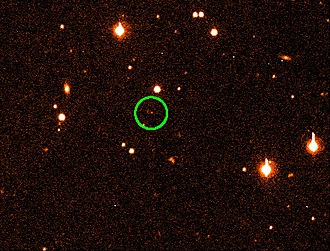Sednoid
Sednoids are a group of distant trans-Neptunian objects (TNOs) with similar orbital characteristics, residing in the outermost reaches of the Solar System. These objects are characterized by their large semi-major axes, high perihelia, and substantial inclination with respect to the ecliptic plane. The most famous member of this group is 90377 Sedna, discovered in 2003, which lent its name to the category. Sednoids are of significant interest to astronomers as they provide insights into the processes at play in the distant Solar System and the potential existence of a hypothetical ninth planet, often referred to as Planet Nine or Planet X.
Discovery and Classification
The discovery of 90377 Sedna by a team led by Mike Brown at the Palomar Observatory marked a significant milestone in the study of the outer Solar System. Sedna's discovery was soon followed by the identification of other objects with similar orbital characteristics, leading to the classification of these objects as Sednoids. These objects have semi-major axes greater than 150 astronomical units (AU) and perihelia greater than 30 AU, distinguishing them from other known TNOs and Kuiper Belt Objects (KBOs).
Orbital Characteristics
Sednoids are noted for their extreme orbits, which are highly elongated and take them far beyond the Kuiper Belt, a region of the Solar System populated by icy bodies and dwarf planets. The orbits of Sednoids suggest that they may be influenced by the gravitational pull of unseen celestial objects, possibly a distant, undiscovered planet or the remnants of a star passing near the Solar System in its early history. The dynamics of their orbits are a subject of ongoing research and debate among astronomers.
Physical Characteristics
Little is known about the physical characteristics of Sednoids due to their great distances from Earth. Observations suggest that they are likely composed of a mixture of ice and rock, similar to other TNOs. Their surfaces are believed to be reddish in color, indicating the presence of complex organic molecules known as tholins. The size of Sednoids can vary, with Sedna itself estimated to be about 1,000 kilometers in diameter, making it one of the largest known TNOs.
Significance
The study of Sednoids offers valuable insights into the early Solar System and the processes that shaped its formation and evolution. Their peculiar orbits challenge existing models of Solar System dynamics and suggest the presence of yet-to-be-discovered celestial bodies influencing their paths. Additionally, Sednoids may hold clues about the distribution of mass in the outer Solar System and the potential for life in extreme environments.
Future Exploration
The remote location and faint visibility of Sednoids make them challenging targets for observation and study. Future missions and advances in telescope technology may provide more detailed information about their physical properties and the nature of their orbits. The exploration of Sednoids represents a frontier in Solar System science, offering the potential to unlock mysteries of the distant outer Solar System.
Transform your life with W8MD's budget GLP-1 injections from $125.
W8MD offers a medical weight loss program to lose weight in Philadelphia. Our physician-supervised medical weight loss provides:
- Most insurances accepted or discounted self-pay rates. We will obtain insurance prior authorizations if needed.
- Generic GLP1 weight loss injections from $125 for the starting dose.
- Also offer prescription weight loss medications including Phentermine, Qsymia, Diethylpropion, Contrave etc.
NYC weight loss doctor appointments
Start your NYC weight loss journey today at our NYC medical weight loss and Philadelphia medical weight loss clinics.
- Call 718-946-5500 to lose weight in NYC or for medical weight loss in Philadelphia 215-676-2334.
- Tags:NYC medical weight loss, Philadelphia lose weight Zepbound NYC, Budget GLP1 weight loss injections, Wegovy Philadelphia, Wegovy NYC, Philadelphia medical weight loss, Brookly weight loss and Wegovy NYC
|
WikiMD's Wellness Encyclopedia |
| Let Food Be Thy Medicine Medicine Thy Food - Hippocrates |
Medical Disclaimer: WikiMD is not a substitute for professional medical advice. The information on WikiMD is provided as an information resource only, may be incorrect, outdated or misleading, and is not to be used or relied on for any diagnostic or treatment purposes. Please consult your health care provider before making any healthcare decisions or for guidance about a specific medical condition. WikiMD expressly disclaims responsibility, and shall have no liability, for any damages, loss, injury, or liability whatsoever suffered as a result of your reliance on the information contained in this site. By visiting this site you agree to the foregoing terms and conditions, which may from time to time be changed or supplemented by WikiMD. If you do not agree to the foregoing terms and conditions, you should not enter or use this site. See full disclaimer.
Credits:Most images are courtesy of Wikimedia commons, and templates, categories Wikipedia, licensed under CC BY SA or similar.
Translate this page: - East Asian
中文,
日本,
한국어,
South Asian
हिन्दी,
தமிழ்,
తెలుగు,
Urdu,
ಕನ್ನಡ,
Southeast Asian
Indonesian,
Vietnamese,
Thai,
မြန်မာဘာသာ,
বাংলা
European
español,
Deutsch,
français,
Greek,
português do Brasil,
polski,
română,
русский,
Nederlands,
norsk,
svenska,
suomi,
Italian
Middle Eastern & African
عربى,
Turkish,
Persian,
Hebrew,
Afrikaans,
isiZulu,
Kiswahili,
Other
Bulgarian,
Hungarian,
Czech,
Swedish,
മലയാളം,
मराठी,
ਪੰਜਾਬੀ,
ગુજરાતી,
Portuguese,
Ukrainian
Contributors: Prab R. Tumpati, MD




